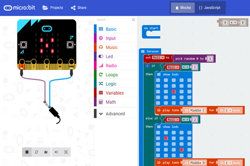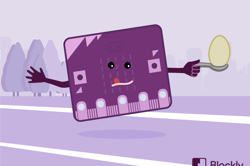DT Challenge - 5/6 Blockly - Chatbot
Write programs to solve problems with code and create word games! In this DT Challenge, you'll learn how to play Mad Libs, Questions, Taboo, and Word Chain, and even write your very own Pirate Chatbot! Can you fool your friends into thinking they're talking to a real person?
Learn how to create a series of word games with code. You'll start out with simple word games and work up to creating your very own Pirate Chatbot! Arrr, me hearties! So get cracking and we'll have you hacking like a pirate in no time!
To do the challenge offline use this guide to support students.
Additional details
| Year band(s) | 5-6 |
|---|---|
| Content type | Student challenges |
| Format | Web page |
| Core and overarching concepts | Implementation (programming), Algorithms, Abstraction, Specification (decomposing problems) |
| Australian Curriculum Digital Technologies code(s) |
AC9TDI6K03
Explain how digital systems represent all data using numbers
AC9TDI6K04
Explore how data can be represented by off and on states (zeros and ones in binary)
AC9TDI6P02
Design algorithms involving multiple alternatives (branching) and iteration
AC9TDI6P05
Implement algorithms as visual programs involving control structures, variables and input |
| Technologies & Programming Languages | other programming languages |
| Keywords | Data: Collection, Representation, Interpretation, Specification, Algorithms, Implementation, Interactions, Australian Computing Academy |
| Organisation | Australian Computing Academy |
| Copyright | University of Sydney. Creative Commons BY 4.0. |
Related resources
-

Micro:bit: Start Coding with the JavaScript Blocks Editor
A range of resources to get you started with the micro:bit - a tiny programmable computer.
-

DT Challenge - 5/6 Blockly - Space Invaders
Use Blockly to learn how to create a Space Invaders game!
-

DT Challenge - 5/6 Blockly- Turtle
Write code to control a turtle and draw fantastic pictures!
-

DT Challenge - 5/6 Blockly - Biology
Combine Biology and Digital Technologies to identify animals!
-

DT Challenge - 5/6 Blockly - Smart Garden
Learn about the BBC micro:bit while creating your own super-sensing Smart Garden!
-

DT Challenge - 5/6 Blockly - Networking with Micro:Bit
Program a micro:bit to create wireless networks and send messages around the room!
-

DT Challenge - 5/6 Blockly - Sport Micro:Bit
Get fit with your micro:bit! Learn about the BBC micro:bit and build your own egg and spoon race micro:bit!
